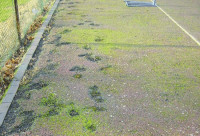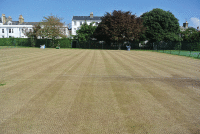
Keep an eye on the outdoor artificials - algae and moss can be prevalent in these damp conditions - regular brushing and treatments will be required.
Key Tasks for November

- grass growth will have slowed down, but certainly not stopped altogether, so you should continue to cut weekly, ensuring that you take no more than a third off in any one cut
- a cylinder mower may still be used, but it is more likely that a rotary mower will serve you better
- box clippings to avoid the spread of disease
- remove leaves and other debris as soon as possible
- sarrel roll when conditions allow
Artificial courts
Keep surface clean with regular sweeping and brushing
Remove any algae and moss from surface. Sand filled systems require regular brushing to maintain manufacturer’s recommendations on sand levels and pile heights
American Fast Dry courts
- keep surface clean, rolling to consolidate surface
- levelling and brushing of fast dry materials, brushing to clean lines
Clay courts
- carry out regular sweeping and brushing to restore playing levels
- topdress any hollows or damaged areas
Tarmacadam
- carry out regular sweeping and brushing
- repair any hollows or damaged areas
With many clubs allowing and, indeed encouraging, play on their artificial surfaces through the winters months (when weather conditions allow) it is imperative that these courts are completely free from moss, algae, leaves or anything else that might pose a slip hazard.
With the sun now lower in the sky, shade problems tend to increase. Shadows remain on the ground for longer periods and these areas tend to take longer to warm up and dry out which, in turn, may affect maintenance operations and playability on all surfaces.




As ever, decisions on agronomic inputs are governed by climactic conditions. October witnessed certain extremes with Atlantic storms delivering forceful winds and heavy rain to the west of the British Isles whilst many other areas simultaneously experienced unseasonal warmth and, for some periods, even sunshine.
Such variability necessitates turf managers at all levels to keep themselves informed of upcoming weather forecasts and also ensure they are suitably prepared with the relevant inputs in stock. This means they are then able to react to application windows swiftly and decisively. Reference to growth degree and growth potential forecasts further allow managers to time inputs when the plant is the most receptive to efficient uptake and utilisation.
Traditionally, November brings with it short, dull days with plenty of rainfall and stormy weather, potentially good for removing leaves off the trees but less favourable for good turf conditions.
November then is a good time to be mindful of good sound cultural practices.
- Remove dews to minimise periods of leaf blade wetness, thereby reducing humidity in the sward canopy and helping to prevent fungal pathogen advance.
- Aerate little and often whenever ground conditions allow to facilitate balanced soil water/air ratios, maintaining aerobic conditions and supporting beneficial soil microorganisms.
- Remove leaves from surfaces to prevent microclimates which promote conditions for pathogen attack and also weaken the plant, making it further susceptible.
- Raise mowing heights to increase leaf surface area and accordingly help the plant to compensate for reduced day length by maintaining photosynthesis potential (the plants energy factory), such that plants can maintain healthy and efficient metabolic function.
Nutritional inputs should be applied with the aim of maximising plant health and resilience through November in a bid to prepare the plant, and thus surfaces, to better cope with the oncoming rigours of December, January and February.
From a feed perspective, adequate nitrogen for plant function is all that is required; forcing growth for aesthetics or recovery from disease scars potentially risks increasing susceptibility to pathogens.
Pay close attention to the secondary micronutrients, sulphur, calcium and magnesium as well as the assorted micronutrients. No one nutrient is more important than the other, they are just required in different quantities. Identifying deficiencies and topping up plant levels with liquid applications is the best way to provide a healthy balanced diet which will allow the plant to be happier, healthier and more resilient in the coming months.
Wetting agents are a go to item at the start of the season with an eye on preventing drought and dry patch. Correct water management should be a prime concern all through the year, with penetrant wetting agents designed to drive water through the profile being the tool of choice from October and November onwards.
Biostimulants are still useful tools through November, whether it be seaweed, sugar or humic substances. Applications should be timed during periods of low disease pressure when they will be most useful to the plant and its associated beneficial microorganisms. Avoid applications during times of pathogenic pressure so as not to further facilitate their function.
Disease management is due to become more challenging following the recent EU vote to not renew the approval of Iprodione on the grounds of human health concerns (Iprodione is an endocrine disruptor). Notification of withdrawal is expected in December, with end of sale and use/disposal of stocks expiry dates expected to come into effect around March and June respectively.
October, November December 2017 then are the last peak fungal disease months where turf managers will be afforded the luxury of a ‘knock it on the head’ active ingredient with which to act reactively to visible signs of disease attack, whether that be mycelium or scarring.
For many months, these diaries have sought to promote the message of Integrated Turf Management with respects to proactive, preventative disease management. Rather than an option, that principle is a rapidly approaching as a necessity.
Anyone seeking further help and advice on such matters should not be afraid to reach out and seek assistance, whether that be from informed peers who are already successfully utilising such techniques, or by telephoning Pitchcare and asking to speak to one of eight BASIS registered advisors, all of whom are trained and accredited in the latest legislative and management practices.

- inspect and clean machinery before putting away for the winter
- replace worn and damaged parts as necessary
- empty fuel tanks as petrol will go stale over winter
- maintain a stock of consumables for your machinery
- secure machinery nightly with good storage facilities and strong locks
- record makes and models and take pictures of your equipment as additional reference
- don’t leave it to the last minute when servicing dealers will be very busy

Some of the other courses available are:
- Chainsaws - CS30 and CS31
- H&S Refresher Training on Combined Turf Care Equipment; Tractors and Trailers; All Mowers (Ride-on and Pedestrian)
- Machinery Courses on ATVs; Tractors: Brushcutters/Strimmers; Mowers (ride-on and Pedestrian)
- Pesticide Application (PA courses)
- Stem Injection of Invasive Species (Japanese Knotweed etc.)
- Basic Trees Survey and Inspection
More details about all the courses can be found on our new Grounds Training website, or you can email Chris Johnson for information.
Other Key Tasks
- repair and maintain fence lines
- cut back any hedges and trees and prune shrubs
- take down and store all tennis equipment, ensuring that it is clean and dry before doing so
- repair/update equipment as necessary
Current topics of discussion on the Pitchcare Forum:


